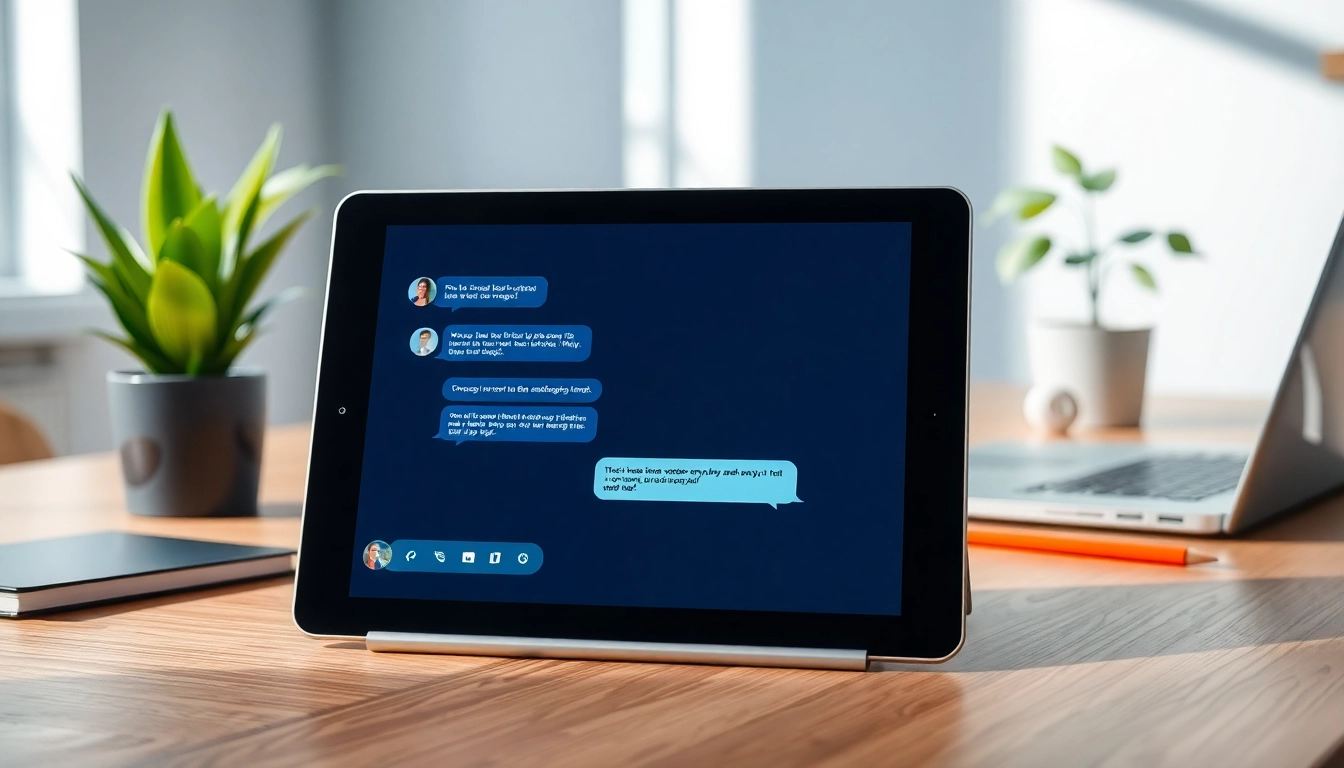Understanding the Basics of chatgpt Chatbots
What is a chatgpt chatbot?
A chatgpt chatbot is a conversational agent powered by OpenAI’s GPT (Generative Pre-trained Transformer) technology. Unlike traditional chatbots that rely on scripted responses and limited functionalities, chatgpt chatbots employ machine learning to understand and generate human-like text in real time. This allows them to answer questions, provide recommendations, and engage users in more dynamic and contextual conversations. Their capabilities go beyond mere keyword recognition; they can discern intent, sentiment, and context, facilitating richer interactions with users.
Core features and functionalities
chatgpt chatbots come equipped with a suite of features that enhance their performance and user experience:
- Natural Language Processing (NLP): This allows the chatbot to interpret and respond to user input in a coherent and contextually appropriate manner, making interactions more fluid and human-like.
- Learning Capabilities: chatgpt chatbots continuously learn from user interactions, allowing them to improve their responses and effectiveness over time.
- Multilingual Support: Many chatgpt models support multiple languages, broadening the accessibility of the chatbot across diverse demographics.
- Personalization: By leveraging user data, chatgpt chatbots can tailor interactions to individual preferences, creating a more relevant and engaging experience.
- Integration with Various Platforms: chatgpt chatbots can integrate with social media, websites, mobile apps, and more, extending their utility and user reach.
Benefits of using chatgpt technology
The adoption of chatgpt technology offers numerous advantages for businesses and users alike:
- Enhanced User Engagement: By providing quick, accurate, and personalized responses, chatgpt chatbots enhance user satisfaction and retention.
- 24/7 Availability: These chatbots can operate around the clock, ensuring that users get assistance whenever they need it, thereby improving support capabilities.
- Cost Savings: Reducing the need for human agents for routine inquiries can lead to significant operational savings.
- Scalability: chatgpt chatbots can handle numerous conversations simultaneously without compromising the quality of interaction.
- Data Gathering: They can collect data from user interactions, which can be analyzed for insights into customer behavior, preferences, and trends.
Implementing chatgpt Chatbots in Your Business Strategy
Steps to integrate chatgpt chatbots into workflows
Integrating chatgpt chatbots into your business requires a structured approach:
- Define Objectives: Clarify what you aim to achieve with the chatbot, whether it’s improved customer service, automated sales, or enhanced user engagement.
- Select the Right Technology: Choose a chatgpt framework that aligns with your needs, ensuring it’s compatible with your existing systems.
- Design Conversational Flows: Plan the conversations by outlining common questions and responses while considering different user intents.
- Test Extensively: Before launching the chatbot, conduct thorough testing to refine responses, fix bugs, and enhance accuracy.
- Launch and Monitor: Deploy the chatbot and monitor its performance, collecting feedback for future improvements.
Choosing the right platform for chatbots
Selecting an appropriate platform is crucial for the success of your chatgpt chatbot. Consider the following factors:
- Integration Capabilities: Ensure the platform can easily connect with your existing systems, such as CRM or customer support tools.
- Ease of Use: Opt for a user-friendly interface that enables non-technical staff to manage and update the chatbot effectively.
- Customization Options: The best platforms allow for extensive customization, enabling you to tailor the chatbot’s persona and behavior to fit your brand.
- AI Capabilities: Evaluate the sophistication of the AI behind the platform. A more advanced AI may provide better performance and more human-like interactions.
- Support and Community: Look for platforms with robust support resources and an engaged user community for advice and shared experiences.
Common challenges during implementation
Integrating chatgpt chatbots into your business strategy can come with challenges, including:
- User Acceptance: Users may be skeptical or hesitant to interact with chatbots. Address this through transparent communication about the chatbot’s capabilities and benefits.
- Technical Limitations: Integrating complex systems can lead to compatibility issues. Work closely with IT to ensure seamless integration.
- Response Quality: Initial responses may not meet expectations. Continuously train the chatbot using real user interactions to improve its accuracy.
- Maintenance and Updates: Chatbots require ongoing updates and maintenance. Allocate resources to regularly review and enhance the chatbot’s performance.
- Data Privacy Concerns: Be transparent about data usage and ensure compliance with relevant regulations to build user trust.
Optimizing chatgpt Chatbots for Improved Customer Engagement
Best practices for chatbot communication
To maximize the effectiveness of your chatgpt chatbot, implement these best practices:
- Keep Conversations Natural: Design the chatbot to respond in a conversational tone that mimics human interaction, making it feel more relatable.
- Use Clear and Concise Language: Avoid jargon and complex language to ensure users easily understand the chatbot’s responses.
- Set User Expectations: Clearly communicate what the chatbot can and cannot do. This prevents frustration and enhances user satisfaction.
- Implement Quick Replies: Offer predefined response options when appropriate, allowing users to respond quickly and keeping the conversation flowing.
- Encourage Feedback: Prompt users to provide feedback on their experience, using this data to refine the chatbot’s performance continually.
Utilizing data for chatbot personalization
Effective personalization can significantly enhance user experience. Here’s how to utilize data for this purpose:
- Analyze User Data: Collect and analyze data from previous interactions to understand user preferences, common questions, and typical behaviors.
- Segment Users: Use demographic and interaction data to segment users, allowing the chatbot to tailor its messages based on user profile.
- Apply Contextual Awareness: Implement features that allow the chatbot to remember past interactions or user preferences, creating a seamless conversational history.
- Utilize Predictive Analytics: Leverage predictive techniques to anticipate user needs based on their behavior and proactively provide relevant assistance.
- Implement A/B Testing: Test different personalized responses and strategies to determine which methods yield better engagement and conversion rates.
Examples of successful chatgpt chatbot strategies
Real-life examples can provide inspiration for implementing chatgpt chatbots in your business. Here are a few effective strategies:
- Seamless Customer Service: Companies like Zendesk use chatgpt chatbots to handle preliminary customer inquiries. By quickly resolving common issues, they free customer service agents to handle more complex problems.
- Personalized Shopping Experiences: Retailers such as H&M have implemented chatbots that assist customers in finding suitable clothing based on personal style preferences and previous purchases.
- Engaging Content Delivery: Publishers utilize chatgpt chatbots to summarize articles, recommend related content, and engage users with quizzes and interactive features, increasing user retention rates.
- Proactive Health Monitoring: Healthcare providers use chatbots for patient interaction, enabling users to book appointments and receive reminders while querying basic health issues.
- Educational Support: Educational platforms deploy chatgpt chatbots to tutor students, answer questions about courses, and offer study tips based on individual learning patterns.
Measuring the Success of Your chatgpt Chatbot
Key performance indicators for chatbots
To evaluate the effectiveness of your chatgpt chatbot, it’s essential to track relevant key performance indicators (KPIs). Some of the primary KPIs include:
- Response Accuracy: Measure how accurately the chatbot understands and answers user queries to ensure it meets user expectations.
- User Engagement Rates: Track user interactions to assess how often users initiate conversations and how long they stay engaged.
- Customer Satisfaction Score (CSAT): Solicit feedback from users after their interaction for a quantitative measure of satisfaction with the chatbot’s support.
- Conversion Rates: Monitor how many user interactions lead to desired outcomes, such as sales, appointments, or sign-ups.
- Escalation Rates: Track the frequency of users needing to escalate issues to human agents, providing insight into areas where the chatbot may require improvement.
Analyzing user interaction data
In-depth analysis of user interaction data is critical for continual improvement:
- Data Collection: Gather data surrounding user interactions, including conversation paths, questions asked, and user responses.
- Identify Patterns: Analyze the data to uncover trends in user behavior, frequently asked questions, and common issues faced by users.
- Utilize Analytics Tools: Employ analytics platforms to visualized data, making it easier to interpret and derive actionable insights.
- Feedback Analysis: Regularly review user feedback to identify areas of dissatisfaction or confusion that could indicate a need for improved responses or functionality.
- Iterate Based on Findings: Use insights to make data-driven adjustments, refining the chatbot’s responses and features for ongoing improvements.
Making data-driven adjustments to improve performance
Based on your analysis, here’s how to make effective adjustments to enhance performance:
- Update Conversational Flows: Modify conversation paths based on user behavior insights to ensure a smoother user experience.
- Continuous Learning: Subscribe the chatbot to an ongoing training regimen using new data from user interactions to enhance response quality.
- Testing Variations: Implement A/B testing to compare new strategies against existing ones, determining which yields better results.
- Incorporate User Feedback: Act on feedback from users to address concerns directly and incorporate suggestions for improvement.
- Review KPIs Regularly: Maintain active tracking of KPIs to identify trends over time and make proactive adjustments as necessary.
The Future of chatgpt Chatbots in Digital Communication
Trends shaping the chatbot landscape
The future of chatgpt chatbots is promising, with several emerging trends that are shaping their evolution:
- Increased Use of Voice Recognition: As voice technology advances, chatgpt chatbots will likely incorporate voice functionality, enabling users to interact more naturally.
- Enhanced Personalization through AI: Future chatbots will leverage advanced algorithms to deliver hyper-personalized experiences, understanding user context better than ever.
- Greater Integration with IoT: Chatbots will increasingly interface with IoT devices, allowing users to control smart home appliances or receive alerts directly through chat interfaces.
- Focus on Emotional Intelligence: Future chatbots are expected to possess higher emotional intelligence, allowing them to respond to user emotions appropriately and sensitively.
- Collaborative Chatbots: We can anticipate an evolution towards collaborative chatbots that work alongside human agents to enhance the support experience.
Innovative applications of chatgpt technology
As the technology evolves, new applications are emerging:
- Complex Problem Solving: Chatbots may evolve to address more complex customer queries using advanced reasoning and contextual awareness.
- Marketing Automation: Using chatbots in marketing to nurture leads delivers content based on user engagement, streamlining the sales funnel.
- Interactive Learning: Educational institutions are exploring chatbots as interactive learning aids, providing customizable learning paths for students.
- Data Analysis and Reporting: Future chatbots might analyze data trends and generate reports autonomously, offering real-time business insights.
- Emotional Well-being Support: Companies are exploring using chatbots in mental health support to provide an initial response and guidance for users seeking help.
Preparing for advancements in AI communication
As the capabilities of chatgpt technology continue to advance, organizations should prepare strategically:
- Stay Informed: Keep abreast of the latest developments in AI and chatbot technology to leverage benefits as they arise.
- Invest in Training: Equip your team with the skills needed to understand and deploy advanced chatbot technologies effectively.
- Focus on Ethical Considerations: With increased automation, developing guidelines for ethical chatbot usage, including user data handling and privacy, is critical.
- Adapt Customer Engagement Strategies: Prepare to innovate based on changing user expectations driven by advances in chatbot technology.
- Foster a Culture of Innovation: Encourage experimentation and adaptation, allowing your business to stay agile and responsive in a rapidly changing landscape.



